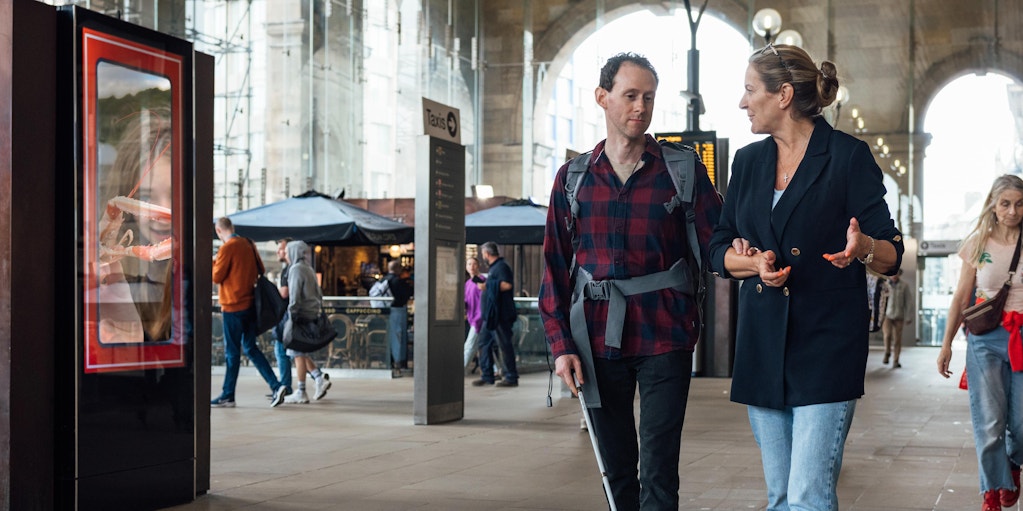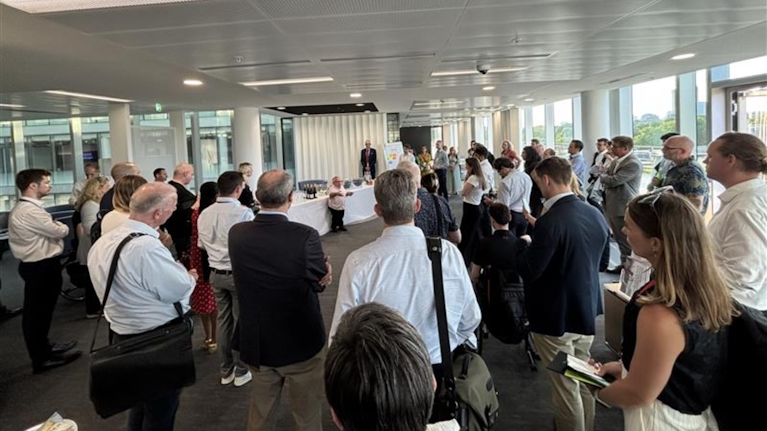
Improving accessibility in transport for more inclusive journeys
Tags
Beyond a social imperative, transport accessibility is a major economic opportunity. Following a recent event with industry leaders, we’ve identified five key lessons for operators, authorities, and government to drive meaningful change.
Access to transport is a basic right. It enables us to lead a fulfilling life; visiting family, commuting to work, accessing healthcare, socialising, the list goes on. However, millions of people across the UK face barriers in accessing and using transportation. This represents not only a social injustice and reflection on our society, but a cost to the economy as well, with research from We Are Purple estimating the potential spending power of individuals with disabilities equates to over £274 billion, much of which is lost from the UK economy due to lack of accessibility. Transport businesses alone lose hundreds of millions of pounds every year by not suitably meeting the needs of disabled people, not to mention other groups such as older people, who face barriers to transportation.
Lack of access can be resolved, but it requires transport operators, government, infrastructure providers, and authorities to work together and ensure that accessibility is prioritised; enabling a better, more equitable, more prosperous society for all.
We recently hosted an event with more than 80 attendees from across government, transport authorities, operators in road, rail, and aviation, start-ups, innovators and accessibility advocates – all coming together to discuss, debate, and start to answer this important challenge. We also brought in experts from other industries to ensure a diverse rage of expertise, backgrounds and capabilities were in attendance. Five key lessons for making transport more accessible emerged from the event. Here, we delve into each one in more detail.

1. Involve people with lived experience in decision making
Involving people with lived experience in decision making is a cornerstone in creating genuinely inclusive solutions. Engagement with people with a variety of accessibility needs will create a more complete and inclusive system, whilst also removing barriers. One in four people in the UK live with some form of disability, not always physical, so the potential implications of planning and design decisions for people with hidden disabilities needs to be considered too.
If you can meet the needs of those with specific access requirements, you are more likely to meet the needs of the general population – commonly known as the ‘curb-cut’ effect – and avoid the trap of tokenist focus groups.
- Conduct research with people with lived experience to uncover critical insights: Engaging directly with people living with disability and those with accessibility needs ensures that design decisions are grounded in real-world experience. This research should be embedded early in the process to shape priorities, not just validate assumptions.
- Take a needs-based (rather than cohort-based) approach: Rather than designing for specific labels or categories (blind and low vision, physical disability, etc.), focus on the full spectrum of needs. For example, if we consider the accessibility of buses, we may consider wheelchair users to be the main population affected. However, if we consider ‘people who need assistance getting onto a bus’, the population becomes much larger to include many others, for example those with temporary injuries, parents with buggies, or people with low vision. Designing for functional needs rather than demographic groups leads to more flexible, inclusive, and future-proof solutions.
- Make research iterative and build long-term partnerships: Inclusion isn’t a one-time checkpoint, it’s an ongoing commitment. It’s vital to repeatedly check in with people with lived experience throughout the design and delivery process to test, refine, and evolve solutions. This creates a feedback loop that ensures the final outcome is genuinely inclusive and accountable, laying the foundations for a long-term success towards more equitable and accessible services.
2. Advocates’ voices must be amplified to change culture
Lack of accessibility is not currently treated in the same way as other exclusionary practices; ableism is not referenced and reacted to in the same way as sexism or racism. As such, accessibility will continue to need champions to push for greater consideration in policy, investments, design, projects, and ways of working across their own organisations to help drive cultural change.
The key challenge here is taking accessibility from a passion area for a small team, to a cultural norm and priority for a whole organisation.
- Make accessibility part of ‘business as usual’: There are many ways to make accessibility considerations part of everyday life in an organisation; include accessibility requirements as a standard question at the start of meetings and in meeting invites, build accessibility as standard into your corporate values and cultural comms, create advocacy networks internally and promote them across the organisation, include accessibility metrics in project KPIs and business cases.
- Build the imperative: Combine the ‘carrot’ of improved economic performance (as per the below) with the ‘stick’ of regulatory requirements and PR impact to help prove the case and build the narrative around accessibility’s importance.
- Give design teams authority to make demands on delivery: Designers are important advocates for the customer during the delivery process. When granted sufficient authority, they can not only work to minimise customer exclusion, but also to avoid costly remediation fixes, for example, being able to stop a new service or experience from going live if accessibility defects are present, or research hasn’t taken place to ensure that user needs are met.
3. Re-balancing the business case will drive different decisions
Research suggests the total spending power of individuals with disabilities in the UK adds up to in excess of £274 billion – known as ‘The Purple Pound’. Much of this is lost from the economy and remains untapped due to lack of accessibility. This is compounded by the social model of disability, which emphasises that individuals are not necessarily disabled by what might be different about them, but that the way that society and infrastructure are set up can inherently ‘disable them’ by making parts of society less accessible and more exclusionary.
Investment decisions and infrastructure set-up are fundamental to driving equitable access. Organisations must redefine the traditional business case to capture the immense commercial and societal value of true accessibility.
- Broaden the benefit considerations: Incorporate accessibility benefits into public infrastructure business cases, as has been the case with the introduction of public health benefits into business cases in the last decade.
- Quantify the lost income: Work to further quantify the income lost, in particular, in use cases for individual entities associated with a lack of accessibility.
- Think about the ‘opportunity cost’: Look to understand the cost impact of the extra work required to serve customers who find themselves excluded from experiences. This may be the cost of call centre resources when individuals with accessibility needs find themselves unable to self-serve digitally, or the cost of increased assistance requests when individuals find themselves unable to board transport or navigate stations independently.
4. Collaboration and combining insights is crucial
With accessible journeys inherently multi-modal, individual organisations must collaborate effectively across the transport ecosystem to solve for the whole customer journey. Sharing ideas between organisations benefits everyone, but then combining these insights into recommendations to help shape policy and set regulation will be crucial.
- Work with like-minded organisations on joint missions: Share lessons and make the most of the networks and connections made by passionate and driven champions. Small working groups between like-minded organisations can often drive significant progress and present challenges back to government where there is meaningful change that could be driven by a updates in policy.
- Engage industry bodies: Use of entities like catapults and Innovate UK Business Connect, who have a role in helping shape and co-ordinate efforts across industry, will be helpful in bringing cross-sector groups together and co-ordinating more coherent and joined up responses and activities.
- Start small-scale pilots: Where cross-modal transport is a must (e.g. getting to / from airports), form small groups with interested parties to run trials of more accessible technologies and projects, documenting lessons and sharing them with industry peers.
5. Progress is better than perfection
The challenge of improving accessibility across the whole transport system can feel overwhelming, with old infrastructure and tight budgets resulting in some organisations feeling paralysed by the sheer size of the problem. Adopting an iterative approach will avoid ‘analysis paralysis’ and deliver improvements now.
- Start with small initiatives that improve your core offering: Starting with small, targeted initiatives within your core service or system can lay a strong foundation for meaningful improvement. Small, demonstrable changes can enable organisations to gather feedback early, learn what works, and refine approaches – all whilst building credibility and trust within their targeted citizen/consumer groups. Incremental steps additionally allow for building internal capacity and awareness, preparing for more ambitious accessibility efforts in the future.
- Prioritise elements that deliver maximum benefit to the largest cohort: With limited resources, it is important to prioritise changes that deliver the greatest impact for the largest groups currently facing exclusion. Utilising data and insights will enable identification of those most affected by barriers and allow for focussed improvements that will address majority needs across diverse groups. This approach not only maximises broad positive impact, but demonstrates responsible stewardship, and lays the groundwork for more targeted accessibility enhancements down the line.
- Recognise that a small change is still seen as positive by the community you are trying to better serve: Don’t be quick to dismiss incremental adjustments as insufficient. For individuals living with disability or accessibility requirements, even relatively small changes often make a meaningful difference in everyday experiences, signalling that an organisation is listening and willing to adapt. Small, positive steps also invite greater engagement from the community and can uncover further opportunities to enhance inclusion over time.
This is by no means the end of the debate (or the start!) – but hopefully it continues the dialogue and connects more people working across the industry together to help improve the lives of millions of people across the UK, one step at a time.
Explore more











